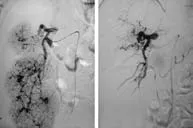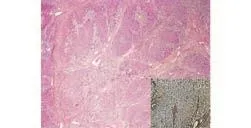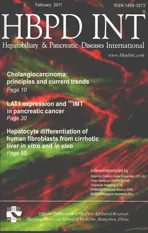Atypical focal nodular hyperplasia of the liver
2011-07-07MuhammadRizwanKhanTaimurSaleemTanveerUlHaqandKanwalAftab
Muhammad Rizwan Khan, Taimur Saleem, Tanveer Ul Haq and Kanwal Aftab
Karachi, Pakistan
Atypical focal nodular hyperplasia of the liver
Muhammad Rizwan Khan, Taimur Saleem, Tanveer Ul Haq and Kanwal Aftab
Karachi, Pakistan
BACKGROUND:Focal nodular hyperplasia, a benign hepatic tumor, is usually asymptomatic. However, rarely the entity can cause symptoms, mandating intervention.
METHOD:We present a case of focal nodular hyperplasia of the liver, which caused a considerable diagnostic dilemma due to its atypical presentation.
RESULTS:A 29-year-old woman presented with a 15-year history of a progressively increasing mass in the right upper quadrant which was associated with pain and emesis. Examination showed a firm, mobile mass palpable below the right subcostal margin. A computed tomography scan of the abdomen showed an exophytic mass arising from hepatic segments III and IVb. Trucut biopsy of the hepatic mass was equivocal. Angiography showed a vascular tumor that was supplied by a tortuous branch of the proper hepatic artery. Surgical intervention for removal of the mass was undertaken. Intra-operatively, two large discrete tumors were found and completely resected. Histopathological examination showed features consistent with focal nodular hyperplasia.
CONCLUSION:This description of an unusual case of focal nodular hyperplasia of the liver highlights the point that the diagnosis of otherwise benign hepatic tumors may be difficult despite extensive work-up in some cases.
(Hepatobiliary Pancreat Dis Int 2011; 10: 104-106)
focal nodular hyperplasia; atypical; liver
Introduction
Focal nodular hyperplasia (FNH), a common benign hepatic neoplasm, accounts for up to 8% of all primary hepatic tumors. Although FNH is asymptomatic in most cases, it may rarely cause symptoms.[1]Despite extensive work-up using an imaging modality in conjunction with biopsy, the distinction of the lesion from other hepatic neoplasms may remain elusive. This diagnostic dilemma in turn poses a challenge in the choice of the most suitable management strategy for FNH. We report here a case of a young patient in whom a pre-operative diagnosis of FNH could not be made definitively despite investigations.
Case report
A 29-year-old woman presented with a 15-year history of a progressively increasing mass in the right upper quadrant. The mass was associated with pain and emesis. An abdominal ultrasound, performed at the time of initial appearance of the mass, had reported it as being a hepatic "Reidel's lobe". Physical examination revealed a firm and mobile mass with smooth edges; it was palpable below the right subcostal margin with extension up to the right lower quadrant of the abdomen. The patient underwent extensive imaging work-up consisting of contrast-enhanced magnetic resonance imaging (MRI) and a computed tomographic (CT) scan of the abdomen (Fig. 1). There was evidence of alarge, exophytic, lobulated and hypervascular mass with diffuse enhancement involving segments III and IVb of the liver. This mass closely abutted the hepatic artery and portal vein in the region of the porta hepatis and extended up to the right iliac fossa. The mass compressed the hepatic veins and appeared to derive its blood supply from branches of the celiac trunk. It measured 19.5 cm cranio-caudally, 15.8 cm antero-posteriorly, and 9.5 cm transversely. These imaging features were atypical for common hepatic neoplasms. Her laboratory workup at that time showed anemia (hemoglobin=10.9 g/dl), deranged liver function tests (ALT=320 U/L, alkaline phosphatase=163 U/L, GGT=190 U/L, AST =172 U/L) and normal alpha-fetoprotein levels. A core biopsy of the hepatic mass was performed and showed reactive and regenerative changes in the tissue. Minute portions of the specimen also showed multiple scattered dilated vascular channels in a fibrous stroma without evidence of any granuloma or malignancy.

Fig. 1. A large, exophytic, vascular and pedunculated mass arising from the liver seen on radiological imaging.

Fig. 2. Arteriogram through the hepatic artery proper shows a large lobulated hypervascular mass in the right lobe of the liver (pre-embolization). After the mass was embolized with polyvinyl alcohol particles and multiple coils, the vascularity of the tumor was markedly reduced (post-embolization).
She was next admitted for surgical exploration. One day prior to surgery, hepatic angiography showed that the tumor was supplied by a tortuous branch of the proper hepatic artery (Fig. 2). An arteriovenous fistula was identified in the inferior pole of the tumor with drainage into the inferior vena cava through the hepatic vein. The artery supplying the tumor was embolized using polyvinyl alcohol particles, gelfoam, and platinum coils to reduce the tumor vascularity before surgery. This resulted in a significant decrease in the vascularity of the tumor with occlusion of the arteriovenous fistula post-embolization (Fig. 2). Surgical excision of the mass was undertaken after the embolization procedure.

Fig. 3. Photomicrograph showing hepatocytes arranged in incomplete nodules separated by fibrous tissue (HE stain, original magnification ×2). The inset shows intact reticulin framework (reticulin stain, original magnification ×2).
Intraoperatively, two discrete tumors were seen as opposed to the imaging finding of a single tumor. One large pedunculated tumor was seen to arise from segment III. Intraoperative ultrasound showed that this tumor had large veins draining into the middle hepatic vein in the umbilical fissure and received its arterial supply from a large aberrant branch of the hepatic artery proper. The second tumor measured 10×10×10 cm and arose from segment IVb. Segments III and IVb were resected and the specimen was submitted for histopathological examination.
Both tumors showed a greyish-white central stellate scar. Histologically, hepatocytes were arranged in incomplete nodules with partial separation by fibrous tissue (Fig. 3). Cell plate architecture demonstrated an intact reticular framework. The final pathological diagnosis of focal nodular hyperplasia of the liver was made. The patient made an uneventful recovery postoperatively and has been well on subsequent follow-ups.
Discussion
The radiological and pathological distinction of FNH from other potentially malignant entities is not always straightforward as this case demonstrates. Contrastenhanced MRI scanning has been reported to be the most sensitive imaging modality for characterizing FNH.[2]In our patient, both MRI and CT scan were used to characterize the hepatic lesion. However, features typical of FNH were not observed despite the use of multiple imaging studies. The lesion could not be sufficiently characterized even with a trucut biopsy and this added to the diagnostic dilemma. Atypical FNH lesions with dysplasia have also been described in the literature where the use of fine needle aspiration cytology preoperatively alluded to a diagnosis of malignancy, but definitive diagnosis of FNH was made only after surgical resection.[3]Although our patient did not have a history of alcohol intake or hepatitis B or Cvirus infections or pre-existing cirrhosis, these clinical attributes may confound the diagnosis further. Our patient denied current or prior use of oral contraceptive pills.
Most authors have advocated conservative management in most cases of FNH where the clinical picture and biopsy findings strongly support the diagnosis.[4,5]However, entities such as hepatic adenoma, hemangioma, the fibrolamellar variant of hepatocellular carcinoma, and metastatic tumors cannot always be definitively differentiated from FNH pre-operatively.[5]Surgical intervention should be considered in patients with onset of symptoms, progressive enlargement, change in consistency of the tumor, persistent pain, bleeding, or lesions that are suspicious on radiological and pathological investigations.[1,5-7]In order to avoid misdiagnosis, hepatic surgery for benign tumors may be undertaken because of the low risk of mortality of such a procedure in young patients with otherwise normal liver parenchyma.[4,5]
In conclusion, the diagnosis of otherwise benign liver tumors may be sometimes very difficult despite extensive imaging work-up and biopsy of the lesion. Atypical presentation, difficulty in preoperative diagnosis, large size, and presence of symptoms mandate surgical exploration and complete resection of the lesion for definitive diagnosis and treatment of symptoms.
Funding:None.
Ethical approval:Not needed.
Contributors:ST wrote the first draft of this commentary. All authors contributed to the intellectual context and approved the final version. KMR is the guarantor.
Competing interest:No benefits in any form have been received or will be received from a commercial party related directly or indirectly to the subject of this article.
1 Bonney GK, Gomez D, Al-Mukhtar A, Toogood GJ, Lodge JP, Prasad R. Indication for treatment and long-term outcome of focal nodular hyperplasia. HPB (Oxford) 2007;9:368-372.
2 Cherqui D, Rahmouni A, Charlotte F, Boulahdour H, Métreau JM, Meignan M, et al. Management of focal nodular hyperplasia and hepatocellular adenoma in young women: a series of 41 patients with clinical, radiological, and pathological correlations. Hepatology 1995;22:1674-1681.
3 Pai R, Khadilkar UN, Diaz E, Prabhu S, Gupta S. Nonclassical focal nodular hyperplasia of the liver in a chronic alcoholic: a diagnostic dilemma on FNAC. Kathmandu Univ Med J (KUMJ) 2009;7:76-78.
4 Cherqui D. Benign liver tumors. J Chir (Paris) 2001;138:19-26.
5 Bathe OF, Mies C, Franceschi D, Casillas J, Livingstone AS. Massive hemorrhage and infarction complicating focal nodular hyperplasia of the liver. HPB (Oxford) 2003;5:123-126.
6 Mentha G, Rubbia-Brandt L, Howarth N, Majno P, Morel P, Terrier F. Management of focal nodular hyperplasia and hepatocellular adenoma. Swiss Surg 1999;5:122-125.
7 Zhang JW, Wang CF, Liu Q, Li JQ. Diagnosis and treatment of focal nodular hyperplasia of liver: report of 23 cases. Zhonghua Yi Xue Za Zhi 2007;87:2531-2533.
December 21, 2009
Accepted after revision May 21, 2010
Author Affiliations: Section of General Surgery, Department of Surgery (Khan MR), Section of Interventional Radiology, Department of Radiology (Haq TU), and Department of Pathology (Aftab K), Aga Khan University Hospital; Medical College (Saleem T), Aga Khan University, Stadium Road, Karachi 74800, Pakistan
Muhammad Rizwan Khan, MBBS, FCPS, FRCS, Section of General Surgery, Department of Surgery, Aga Khan University Hospital, Stadium Road, Karachi 74800, Pakistan (Tel: 92-21-4930051; Fax: 92-21-4934294; Email: khan.rizwan@aku.edu)
© 2011, Hepatobiliary Pancreat Dis Int. All rights reserved.
杂志排行
Hepatobiliary & Pancreatic Diseases International的其它文章
- Laparoscopic liver resection for benign and malignant liver tumors
- Assessment of tumor vascularization with functional computed tomography perfusion imaging in patients with cirrhotic liver disease
- Expression oflamino acid transport system 1 and analysis of iodine-123-methyltyrosine tumor uptake in a pancreatic xenotransplantation model using fused high-resolution-micro-SPECT-MRI
- Hepatobiliary & Pancreatic Diseases International (HBPD INT)
- Roles of sulfonylurea receptor 1 and multidrug resistance protein 1 in modulating insulin secretion in human insulinoma
- Cholangiocarcinoma: principles and current trends
